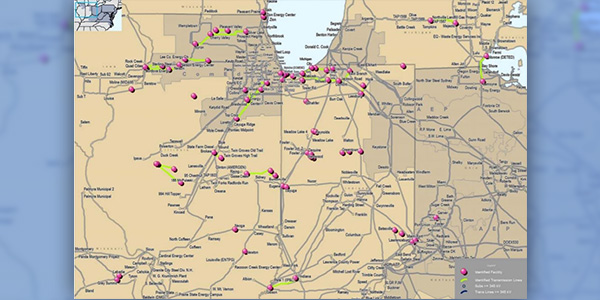By Amanda Durish Cook
MISO and PJM have whittled 20 prospective transmission projects down to two in their search for small interregional upgrades that relieve congestion on market flowgates.
If approved, the two targeted market efficiency projects (TMEPs) will be mostly paid for by MISO, which stands to reap the lion’s share of project benefits, stakeholders learned during an Oct. 5 conference call held by the RTOs’ Interregional Planning Stakeholder Advisory Committee (IPSAC).
MISO and PJM began the study process in spring, identifying 61 facilities that amassed about $500 million in congestion over 2016 and 2017. (See “Possible Interregional Projects,” FERC OKs MISO-PJM Double Charge Fix for Pseudo-ties.)
A TMEP must cost less than $20 million, completely cover its installed capital cost within four years of service and be in service by the third summer peak from its approval. The process has a shorter outlook than the RTOs’ interregional market efficiency project process, which evaluates projects over a 15-year timeline.
Alex Worcester, PJM interregional planning engineer, said the two projects that meet TMEP criteria will be recommended to the RTOs’ boards in December:
- An upgrade on terminal equipment on the Marblehead 138/161-kV transformer in southeastern Michigan to increase its summer emergency rating. The facility has had $15.5 million in historical congestion. The RTOs said a $175,000 upgrade could yield $12.4 million in benefits within four years of service. MISO would pay for the entire project because it would reap all the project’s benefits, Worcester said.
- A $4.3 million substation equipment upgrade to the Gibson-Petersburg 345-kV facility in southwestern Indiana. The tie has experienced $9.8 million in historical congestion over 2016 and 2017, and the project could provide a $19.5 million benefit within four years. MISO would cover 93% of the project cost, and PJM would cover the balance, pursuant to RTO benefits.
Worcester said the 18 remaining project candidates were disqualified from the TMEP process either because upgrades were already planned, upgrade costs were too high, the flowgate congestion was merely outage-driven or the issue was alleviated by the April retirement of We Energies’ Pleasant Prairie coal plant in southeastern Wisconsin.
MISO and PJM also said two northern Indiana flowgates that were being investigated for potential TMEPs — the Dumont-Stillwell 345-kV tie linking Northern Indiana Public Service Co. and American Electric Power territories, and NIPSCO’s Michigan City-Trail Creek 138-kV line — may be eligible in a future study to identify a larger interregional MEP project.




